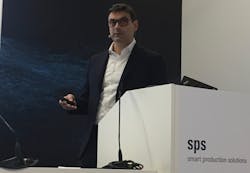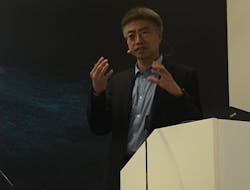Bosch Rexroth and Siemens Collaborate with Qualcomm on 5G

A key tenet of nearly all industrial 5G discussions is that 5G is the key to truly enabling Industry 4.0. After all, reliably transmitting the massive amounts of data captured today for processing at the edge or in the cloud, or in transfers between machines and systems within a company—at industrial scale—will require significantly more bandwidth than that offered by 4G LTE. And the amount of data being transferred today is poised to grow exponentially in the next few years alone.
But 5G is only just now beginning to be rolled out and is not yet available in many areas. However, one area of the globe currently leading the way with 5G is Europe, said Sebastiano Di Filippo, senior director, business development for Qualcomm Technologies Europe. As an example of Europe’s advanced activity in this area, he noted that the European Commission recently announced that it is “harmonizing its 26GHz radio spectrum band for 5G.”
As for 5G’s application in industry, Di Filippo said “real time computing at the edge is a major application for 5G.” With this in mind, specific factory applications Qualcomm is investigating for 5G include wearable devices, automated guided vehicle, robots, wireless edge analytics, sensors, and computer vision.
At the SPS (Smart Production Solutions) 2019 event in Nuremberg, Qualcomm announced two industrial 5G proof-of-concept projects it is involved in—one with Bosch Rexroth and one with Siemens.
The joint demo of this project showcased at SPS features two industrial devices operating in a time-synchronized manner over a wireless connection—showing that the combination of TSN and 5G can enable precise synchronization without the need for a wired connection. For this project, Bosch Rexroth is using its new ctrlX Automation system, with two ctrlX Core controllers interacting with each other in real time over a 5G test network using a Qualcomm Technologies 5G industrial test device.
“Our ctrlX Automation platform will allow industrial machine manufacturers using TSN to choose between real-time wired industrial Ethernet or real-time 5G wireless communication according to their needs without having to change the machine application,” said Gunther May, director of technology at Bosch Rexroth.
Qualcomm’s project with Siemens is a joint proof-of-concept project at the Siemens Automotive Test Center in Nuremberg, Germany. The objective of this project is to demonstrate the first private 5G stand-alone network in a real industrial environment.
At the Siemens Automotive Test Center, Qualcomm is providing the 5G test network and 5G industrial test devices, with Siemens supplying its Simatic control system, I/O devices, and automated guided vehicles.
Test application such as these are critical in these early days of the 5G rollout, as applications of the technology are expected to grow quickly. In the recent IHS “The 5G Economy” report, researchers stated that manufacturing will comprise nearly $4.7 trillion in 5G-related sales enablement by 2035. According to IHS, this represents 36% of the $13.2 trillion opportunity of 5G, and is by far the largest industry to be impacted by 5G beyond consumer mobile applications.

